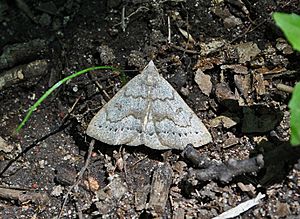Chytolita facts for kids
Quick facts for kids Chytolita |
|
|---|---|
 |
|
| Scientific classification | |
| Synonyms | |
|
The Chytolita is a type of moth known as a litter moth. It belongs to the Erebidae family. This group of moths was first named by Augustus Radcliffe Grote in 1873. The only species in this group is Chytolita morbidalis. It is also called the morbid owlet moth or morbid owlet.
This moth was first officially described by Achille Guenée in 1854. You can find it across a large part of North America. It lives from the east coast to the west coast in the northern areas. In the south, it can be found as far as North Carolina, Texas, and Florida. These moths like to live in deciduous woods and along their edges.
Contents
About the Morbid Owlet Moth
What the Morbid Owlet Moth Looks Like
The morbid owlet moth has a wingspan of about 29 to 35 millimeters. That's roughly the length of two to three paper clips. Its front wings are a pale grayish-white color. They have soft, brownish or orangish lines. The back wings are even lighter in color. They have faint grayish lines that look like veins.
Where it Lives and What it Eats
Adult morbid owlet moths are usually seen flying from May to August. It seems that there is one main group of moths born each year.
The young moths, called larvae or caterpillars, eat the leaves of different deciduous trees. Scientists have raised them on plants like dandelion, grass, hazel, and lettuce. They have also been found eating dead leaves. This includes dried white oak leaves.
Understanding the Morbid Owlet Moth's Family Tree
For a while, another moth called Chytolita petrealis was thought to be a separate species. However, scientists now consider it to be the same as C. morbidalis. This change happened because of something called DNA barcoding.
DNA barcoding is a way to identify species using a small piece of their DNA. When scientists looked at the DNA of both forms of these moths, they found they were very similar. This showed that they are actually the same species. The smaller, darker "petrealis" form was once known by names like lesser gray chytolita or stone-winged owlet.

